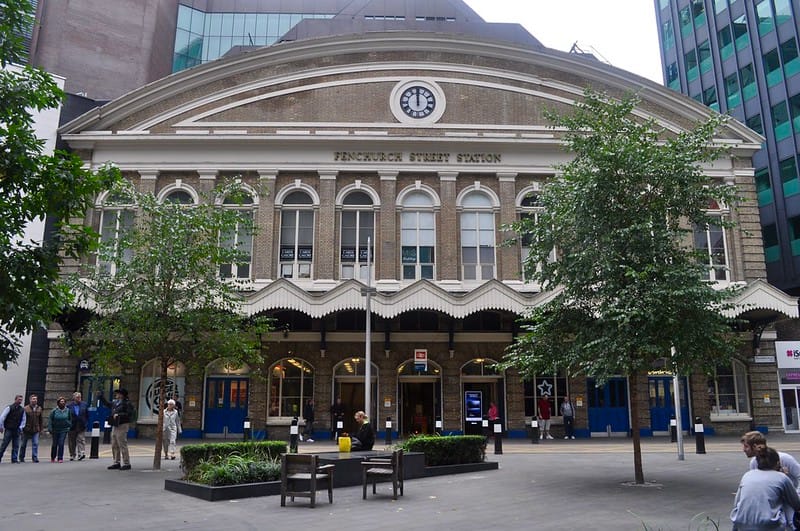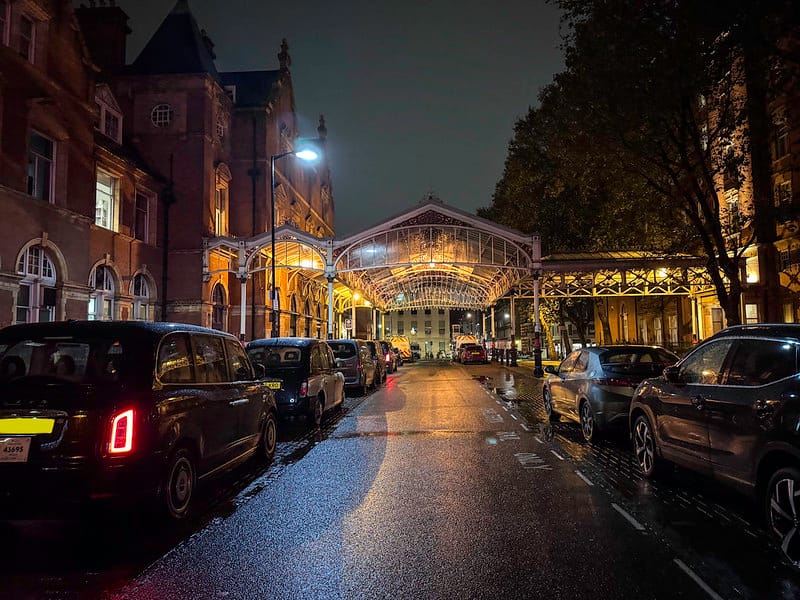Trains from London (all stations) to Inverness stop at a list of impressive extremes: Britain’s highest mountain, Ben Nevis; the deepest freshwater loch, Loch Morar; and the 21-arched Glenfinnan viaduct.
There’s nothing more romantic than dozing off in a sleeper train cabin, then waking up to the ruggedly handsome scenery of rural Scotland. Plan your London to Inverness trip with our online journey planner and timetables.
Inverness Station
The hub of our Scotland tours, Inverness is a quaint town that serves as your home base during the trip. After arriving, stroll the picturesque streets and take in the views of the River Ness flowing through the city center. If you have time before the evening tour begins, you may want to get acquainted with the area on a leisurely riverside walk or visit one of Inverness’ top attractions, such as the 13th-century Inverness Castle.
Inverness railway station is set back from a busy street in the heart of the city center. The station is a short walk to many of Inverness’ best attractions, including Inverness Castle and Loch Ness. You can also spend some time shopping at the nearby Eastgate Mall, a large mall populated with stores that you’ll recognize from back home. Be sure to check out the Victorian Market if you’re looking for some authentic Scottish souvenirs to bring home with you.
Opened in 1855, Inverness Railway Station is a major train station that’s operated by Abellio ScotRail. Frequent ScotRail trains connect Inverness to many other cities throughout the UK, including Aberdeen, Edinburgh, Glasgow, and London. Once you arrive at the station, you’ll find an abundance of shops, restaurants, and bars. If you’re in need of a break from the train ride, head over to The Malt Room for a dram and a chat with a local or Hootananny for some traditional Scottish folk music—even Mumford and Sons have played here!
If you’re ready to experience a trip through the beautiful Scottish Highlands, browse our selection of rail holidays. Each package includes return flights, quality accommodation, meals, luxury coach transport, and the services of an experienced tour director to ensure that you’re taken care of every step of the way.
Culloden Battlefield
Trains arrive at Inverness Station each day from London, Edinburgh and Glasgow. From here, it’s easy to explore the Highlands by bus or by rail. The scenic Caledonian Sleeper overnight train is a great option for those who want to get straight to the action in the evening and return home refreshed in the morning.
On 16 April 1746, the final battle of the Jacobite Rising came to brutal head at Culloden Battlefield. Here, government troops led by the Duke of Cumberland fought Jacobite supporters seeking to reinstate Prince Charles Edward Stewart to the British throne. It was the last pitched battle to be fought on British soil and, in less than an hour, ended in the utter defeat of the Jacobites. The harrowing battlefield is now a national monument and the richly researched, stimulating and sensitive Culloden Visitor Centre is designed to help visitors understand what happened and why.
The battlefield is now a visitor attraction with areas of the moor returned to their appearance as they would have been in 1745. You can view the burial grounds of the clansmen who died and learn more about the battle and its gruesome aftermath from an interpretive center. A large stone marks the location where government commander, the Duke of Cumberland, stood to observe the battlefield. The site is also a major center for reenactments in summer and winter.
From Inverness you can explore more of the Scottish Highlands by train, with options to visit John O’Groats – the most northerly point of mainland Britain – or Aviemore in the Cairngorms National Park for mountain hikes and skiing. Or you could take the Kyle Line to enjoy a scenic journey past wooded hillsides, shimmering lochs and idyllic villages.
Loch Ness
Spectacular natural scenery, a storied history, and legendary monsters await on this escorted tour of the Scottish Highlands. From your base in the quaint capital city of Inverness, journey to a soaring mountain summit and an eerie loch that has inspired legends about a prehistoric creature. During the two-day escape, you’ll also drive by Stirling Castle, an ancient fortress perched atop a hill and admire the beauty of the Cairngorms National Park.
Loch Ness is one of the most famous lakes in the world, and its mystical waters have inspired tales of an aquatic monster. You’ll have the chance to explore the eerie loch on an optional boat cruise, as well as enjoy views of a ruined castle perched above its shores.
Like many deep lochs throughout the world, Loch Ness is said to be home to a legendary plesiosaur. Several sonar explorations have been carried out in an attempt to find the fabled beast, but the results were inconclusive. Nevertheless, the possibility of a surviving plesiosaur remains to intrigue the curious.
After a day of exploring Loch Ness, visit the historic village of Fort Augustus and enjoy its scenic surroundings. Then, take a drive along the banks of the Great Glen and stop for photos above the ruins of Urquhart Castle. Later, board the gleaming Jacobite steam train at Fort William and enjoy stunning scenery as it crosses the mighty Glenfinnan Viaduct. Finally, savor lunch in the picturesque fishing port of Mallaig before heading back to Inverness.
Glen Urquhart Castle
Located in the Great Glen, Urquhart Castle looks over the famous Loch Ness. The name is thought to come from Gaelic words meaning “by the woodland.” The ruins of this former 13th-century fortress were damaged during the final battle of the Jacobites with the English in 1692, and its position on an island at the top of a deep lake has made it one of Scotland’s most memorable landmarks.
The castle was passed back and forth as the Scots and English struggled for control. When the King of England Edward I stayed here in 1297 it was with an impressive entourage that included bishops and lords and a castle constable. He managed to fend off a local attack that left the garrison shaken.
Later in the 14th century when Robert the Bruce became King of Scots he began feuding with John Comyn, and as he gained momentum many of the Comyn family’s strongholds fell. Urquhart became the property of the Earl of Moray.
A wooden gangway crosses the remains of the original defensive ditch to get to the castle. Inside the gatehouse there’s a display about Historic Environment Scotland and another door leads to a small prison cell where prisoners were kept.
You’ll also find a visitor centre and gardens. The site is open from April to October. It’s best to arrive during the week as it can be very busy on weekends.
Inverness is a thriving city with interesting locations and great museums. It’s a great base to explore the majesty of Loch Ness and the wilderness of the Highlands. You can even take a day trip over to the Isle of Skye for unforgettable mountainous landscapes.
Isle of Skye
The Isle of Skye is a land of epic landscapes and incredible history, a destination that can be easily explored by train and foot. Settle in on the famed West Highland Line, which is known to many as the Hogwarts Express due to its appearance in the Harry Potter films, and watch brooding lochs and leafy glens roll by from your cabin window.
Upgrade to First Class on the Caledonian Sleeper for more legroom and reclining seats. The trip is made even more relaxing by the fact that you’ll sleep in a cozy bed, waking up to breakfast served right in your compartment.
After a night on the train, spend your final day in Inverness exploring its sights. Visit the Inverness Museum and Art Gallery to learn about local culture, or head out on a half-day trip to Loch Ness and Urquhart Castle or Culloden Battlefield.
From here, it’s on to the far north of Scotland, where rugged mountains, pristine lochs and charming villages await. Travel along the Kyle Line between Inverness and Mallaig to see a different side of the Scottish Highlands, or ride a famous steam train like the Jacobite.
The West Highland Line runs from Glasgow up north through Crianlarich to Fort William and Mallaig, where you can catch ferries over to the Isle of Skye and other islands. Alternatively, four ScotRail sprinter trains a day link Fort William and Mallaig with Edinburgh, Glasgow and Aberdeen, passing through the wilds of Rannoch Moor. This is one of the most beautiful rail journeys in the world. It was built through some of the most remote and difficult terrain in Scotland, requiring many viaducts and cuttings to be constructed over a period of 100 years.



